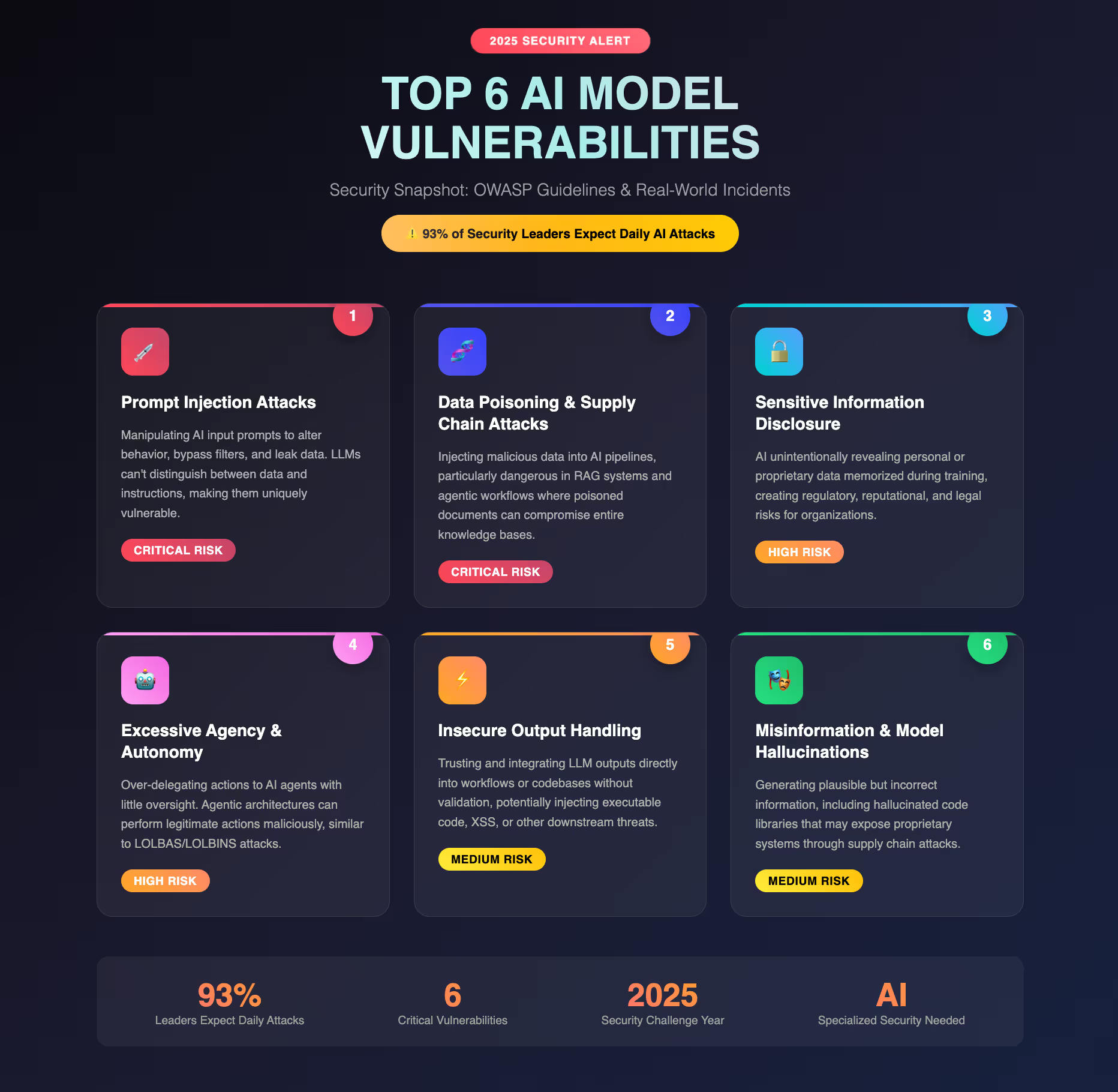Top 6 AI Model Vulnerabilities in 2025: A Critical Security Guide

Top 6 AI Model Vulnerabilities in 2025: A Critical Security Guide
As artificial intelligence continues its rapid integration into business operations and daily life, the security landscape is evolving dramatically. 93% of security leaders expect their organizations to face daily AI-driven attacks by 2025, making AI security more critical than ever. The vulnerabilities we face today are fundamentally different from traditional software security issues, requiring specialized approaches and understanding.
Based on the latest research from cybersecurity experts, OWASP guidelines, and real-world incident reports, here are the Top 6 AI model vulnerabilities organizations must address in 2025—along with recommended countermeasures and how Starseer.ai can assist.
The List
1. Prompt Injection Attacks
What it is: Manipulating an AI’s input prompt to alter its behavior.
Real-world impact: Bypasses filters, leaks data, and subverts intended use (e.g., tampering with AI-driven hiring systems).
Why it's critical: LLMs don’t distinguish clearly between data and instructions, making them uniquely susceptible to manipulation.
How to Address:
- Apply strict input sanitization and prompt parsing.
- Apply open source guardrails to prevent unwanted behaviors, i.e., Nemo-Guardrails from NVIDIA, LlamaGuard/PromptGuard from Meta, or ShieldGemma from Google.
- Use isolated system prompts and instruction delimiters.
- Implement allow/deny lists for AI response behaviors.
- Look for guides and best practices that can assist, such as:
- https://simonwillison.net/2025/Apr/11/camel/
- https://docs.aws.amazon.com/bedrock/latest/userguide/prompt-injection.html
- https://azure.microsoft.com/en-us/products/ai-services/ai-content-safety
- https://developers.google.com/checks/guide/ai-safety/guardrails
- https://cloud.google.com/blog/products/identity-security/introducing-ai-protection-security-for-the-ai-era
Starseer’s Platform: Continuously tests LLM behavior against injection patterns and maintains a real-time prompt abuse detection engine.
2. Data Poisoning and Supply Chain Attacks
What it is: Injecting malicious data into AI pipelines can bias or degrade performance. This is particularly concerning in Retrieval Augmented Generation (RAG) contexts, where a document referenced by the LLM might be poisoned with a prompt injection or other malicious content that causes the model to misinterpret or misrepresent the information within the reference. Similarly, when models are equipped with function calling and tool use capabilities (often called "agentic" systems)—such as internet browsing—this creates an attack vector for "poisoning" the information flowing into the model from tools or capabilities that are presumed to be trusted.
Real-world impact: Leads to incorrect or harmful AI outputs in safety-critical environments such as healthcare or autonomous vehicles. Furthermore, as more teams are pushed toward AI adoption or witness the efficiencies gained through LLMs and AI-supported workflows, they are integrating these systems with internal knowledge bases without realizing that every new document added to the KB becomes accessible to 5-10 different departmental AI workflows that all leverage the same knowledge base.
Why it's critical: Open datasets and third-party sources increase attack surfaces.
How to Address:
- Follow common vulnerability management best practices, including:
- Identify assets (models) and workflows
- Map the model system for information going into and out of the model
- Apply threat modeling principles to identified AI system workflows
- Vet and version control all training data sources, including those for fine-tuning. Models can be poisoned so that is where model provenance tracking is important for the "be careful where X or Y specific version of a model is pulled from."
- Use bias detection to identify data outliers or backdoors.
Starseer.ai: Offers supply chain visibility and alerts when training data integrity is compromised or anomalous patterns emerge through prompt scanning.
3. Sensitive Information Disclosure
What it is: AI unintentionally revealing personal or proprietary data memorized during use.
Real-world impact: Leaks of PII, trade secrets, or sensitive internal content. Here are some examples of easy sensitive information disclosure:
- Public chatbot: A customer service bot accessed internal knowledge bases to help troubleshoot issues. An 8-year-old page with legacy system passwords had never been found in audits, but the model discovered and shared these credentials with a customer.
- Internal bot with caching: To reduce costs, a company chatbot cached prompts containing the CEO's financial data. When a department head asked about budget projections, the bot returned the cached sensitive information.
- Internal bot with web search: A company chatbot was given an employee's medical information for research. It performed web searches using queries like "XYZ employee medical issue," potentially exposing sensitive health data.
Why it's critical: Creates regulatory, reputational, and legal risks.
How to Address:
- Limiting and scoping LLMs and AI workflows to only necessary information is crucial for maintaining data privacy. Assume that any document within a RAG system can be extracted or viewed without summarization—if this poses a risk, implement stronger document classification.
- Apply differential privacy techniques
- Limit training and use on sensitive or unstructured datasets
- Monitor outputs for known sensitive patterns or entities
Starseer.ai: Detects information leakage through memory probing tests and red-teaming of LLMs for memorization risks.
4. Excessive Agency and Autonomy
What it is: Over-delegating actions to AI agents, tooling and capabilities that the models are provided with little oversight.
Real-world impact: Unchecked AI actions resulting in unauthorized operations or data loss.
Why it's critical: Agentic architectures are gaining popularity, particularly in workflow automation. Drawing a security parallel with LOLBAS/LOLBINS, anything the model can do for legitimate purposes could also be leveraged maliciously.
How to Address:
- Establish role-based access for agents and apply human-in-the-loop controls. Regularly audit HITL review frequency.
- Define strict boundaries for autonomous decision-making.
- Simulate decision paths before production deployment.
Starseer.ai: Audits agent behaviors in sandbox environments and provides policy-based guardrails for autonomous actions.
5. Insecure Output Handling
What it is: Trusting and integrating LLM outputs directly into workflows or codebases. Developments such as structured output help provide consistency for scanning and audit workflows, however it is still a challenge for many language models.
Real-world impact: Injection of executable code, XSS, or other downstream threats.
Why it's critical: AI is increasingly used to auto-generate code, config, and business logic.
How to Address:
- Always validate and sanitize outputs before execution. Use guardrails to ensure that creative wording can't get accepted.
- Use static and dynamic analysis on generated code.
- Apply filters for known bad patterns in text or HTML.
Starseer.ai: Validates AI-generated outputs against security policies and flags potentially dangerous content or functions.
6. Misinformation and Model Hallucinations
What it is: Generating plausible but incorrect or misleading information.
Real-world impact: Inaccurate business reporting, compliance errors, or public disinformation can result from AI outputs. An interesting aspect of model hallucinations and misinformation that translates into supply chain attacks occurs when models generate code. Depending on their training data or reinforcement learning, they may "hallucinate" real libraries that are internal-only, potentially exposing proprietary systems.
Why it's critical: Users trust confident, fluent responses—regardless of their accuracy.
How to Address:
- Implement grounding techniques like verified knowledge bases.
- Require evidence citations for factual queries.
- Continuously test models for accuracy across knowledge domains.
Starseer.ai: Detects hallucinations through truth-checking engines and validates factual claims against known sources.
Protecting Your Organization: Key Recommendations
- Implement Multi-Layered Validation: Validate inputs and verify outputs for safety and correctness.
- Monitor Resource Usage: Throttle usage and detect cost anomalies to prevent DoS or model abuse.
- Perform Regular Security Assessments: Use red teaming and automated tools to test AI behavior and controls.
- Secure the AI Supply Chain: Vet third-party data sources and apply provenance tools.
- Enable Continuous Monitoring: Use real-time observability to catch evolving threats, anomalies, and policy violations.
- Stay Vigilant: This field is under active development and requires staying current with the latest attacks and security news. As AI labs continue learning about model capabilities and discovering novel attack vectors, the threat landscape is constantly evolving.
The OWASP for LLM Applications and AI Agents offer an excellent starting point. But as the AI threat landscape evolves, so must your defenses. Security must evolve with innovation—treating your AI like any other business-critical system. Those who invest in continuous AI validation will not only reduce risk—they will lead.
The Path Forward
The AI security landscape will continue to evolve. Emerging threats like synthetic data poisoning, agent abuse, and prompt leaks are no longer theoretical—they are actively being exploited. Traditional application security methods are not sufficient to defend against AI-specific threats.
Starseer offers a comprehensive platform for AI model validation, adversarial testing, and behavior monitoring - Starseer Probe, Defend, and Audit. By continuously probing models, offering real-time mitigation recommendations, and auditing, Starseer ensures your AI systems are safe, aligned, and trustworthy.
Take control of your
AI environment.
Ready to reduce your AI risk? Our platform helps you reduce exposure, harden models, & move at the speed of business AI.

Join our newsletter to stay up to date on Starseer news, features, and releases.
© 2025 Copyright - Starseer, Inc.
